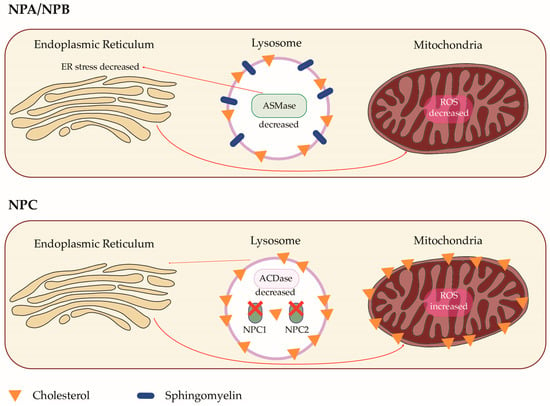Niemann–Pick Disease (NPD) is a rare autosomal recessive disease belonging to lysosomal storage disorders. Three types of NPD have been described: NPD type A, B, and C. NPD type A and B are caused by mutations in the gene SMPD1 coding for sphingomyelin phosphodiesterase 1, with a consequent lack of acid sphingomyelinase activity. These diseases have been thus classified as acid sphingomyelinase deficiencies (ASMDs). NPD type C is a neurologic disorder due to mutations in the genes NPC1 or NPC2, causing a defect of cholesterol trafficking and esterification. Although all three types of NPD can manifest with pulmonary involvement, lung disease occurs more frequently in NPD type B, typically with interstitial lung disease, recurrent pulmonary infections, and respiratory failure.
- Niemann–Pick Disease
- acid sphingomyelinase deficiency
- SMPD1
- NPC1
- NPC2
- Olipudase α
- miglustat
- lung transplant
1. Introduction

| ASMD Type A | ASMD Type B | NPD Type C | |
|---|---|---|---|
| Age of onset | Childhood | Childhood and adulthood | Mainly childhood, adulthood (underecognized) |
| Lung involvement | Present | Frequent | Rare |
| Hepato-splenomegaly | Frequent | Frequent | Frequent |
| Liver disease | Present | Frequent | Present |
| Neurodegeneration | Frequent and rapidly progressive | Present and slowly progressive | Present and rapidly progressive (in younger patients) |
| Atherosclerosis | Present | Frequent | Not described |
| Growth delay | Frequent | Frequent | Not frequently described |
| Hypotonia | Frequent | Rare | Present |
2. The Genetic Basis of Niemann–Pick Disease Type A and B: Disease-Causing Mutations and Genotype–Phenotype Relationships
3. Acid Sphingomyelinase Deficiencies: Clinical Aspects in Niemann–Pick Disease Type A and B
3.1. Niemann–Pick Disease Type A (ASMD Type A)
3.2. Niemann–Pick Disease Type B (ASMD Type B)
3.3. Niemann–Pick Disease Type A/B (ASMD Type A/B)
4. The Genetic Basis of Niemann–Pick Disease Type C: Disease-Causing Mutations and Genotype–Phenotype Relationships
5. Niemann–Pick Disease Type C: Clinical Aspects
This entry is adapted from the peer-reviewed paper 10.3390/biom14020211
